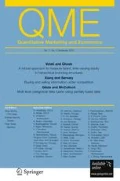Abstract
The predictive relationship of a large and comprehensive set of personal descriptors to aspects of product and brand use is examined. The descriptors comprise demographic and general psychographic variables frequently used in segmentation studies and studies of consumer purchase behavior. The evidence is overwhelming that the covariates are related to brand use in an identical way for all brands, indicating that they are not useful for predicting relative brand preference. The covariates are shown to be predictive of product use. Discussion of the explanatory content of the variables is offered.
Similar content being viewed by others
References
Allenby, Greg M. (1990). “Hypothesis Testing with Scanner Data: The Advantage of Bayesian Methods”, Journal of Marketing Research 27, 379-389.
Allenby, Greg M. and Peter E. Rossi. (1991). “Quality Perceptions and Asymmetric Switching Between Brands”, Marketing Science 10, 185-205.
Allenby, Greg M. and Peter E. Rossi. (1999). “Marketing Models of Consumer Heterogeneity”, Journal of Econometrics 89, 57-78.
Allenby, Greg, Geraldine Fennell, Albert Bemmaor, Vijay Bhargava, Francois Christen, Jackie Dawley, Peter Dickson, Yancy Edwards, Mark Garratt, Jim Ginter, Alan Sawyer, Rick Staelin, and Sha Yang. (2002). “Market Segmentation Research: Beyond Within and Across Group Differences”, Marketing Letters 13(3), 231-241.
Arora, Neeraj, Greg M. Allenby, and James L. Ginter. (1998). “A Hierarchical Bayes Model of Primary and Secondary Demand”, Marketing Science 17, 29-44.
Anderson, W. Thomas Jr. (1971). “Identifying the Convenience-Oriented Consumer”, Journal of Marketing Research 8, 179-183.
Bawa, Kapil, Srini S. Srinivasan, and Rajendra K. Srivastava. (1997). “Coupon Attractiveness and Coupon Proneness: A Framework for Modeling Coupon Redemption”, Journal of Marketing Research 34, 517-525.
Bass, Frank M., Douglas J. Tigert, and Ronald T. Lonsdale. (1968). “Market Segmentation: Group Versus Individual Behavior”, Journal of Marketing Research 5, 264-270.
Bayus, Barry L. and Raj Mehta. (1995). “A Segmentation Model for the Targeted Marketing of Consumer Durables”, Journal of Marketing Research 32, 463-469.
Belk, Russell, W. (1974) “An Exploratory Assessment of Situational Effects in Buyer Behavior”, Journal of Marketing Research 11, 156-163.
Blattberg, Robert, Thomas Buesing, Peter Peacock, and Subrata Sen. (1978). “Identifying the Deal Prone Segment”, Journal of Marketing Research 15, 369-377.
Bucklin, Randolph E., Sunil Gupta, and Sangman Han. (1995). “A Brand's Eye View of Response Segmentation in Consumer Brand Choice Behavior”, Journal of Marketing Research 32, 66-74.
Chintagunta, Pradeep K. and Sudeep Haldar. (1998) “Investigating Purchase Timing Behavior in Two Related Product Categories”, Journal of Marketing Research 35, 43-53.
Fennell, Geraldine. (1978). “Consumers' perceptions of the product-use situation”, Journal of Marketing 42 (April), 38-47.
Fennell, Geraldine. (1995). Globalization and market segmentation: Back to basics. In S.B. MacKenzie and D.M. Stayman (eds.), Proceedings of the Society for Consumer Psychology. Washington, DC: Society for Consumer Psychology, (Division 23), American Psychological Association.
Fennell, Geraldine. (2000). “Product and Brand: Interchangeable Terms?” In R. Keith Tudor, Ernest Capozzoli, and Daryl McKee (eds.), Advances in Marketing.
Fennell, Geraldine and Greg M. Allenby. (2002). “No Brand Segmentation? Let's Not Rush to Judgement”, Marketing Research 14, 14-18.
Frank, Ronald E., William F. Massy, and Harper W. Boyd. (1967). “Correlates of Grocery Product Consumption Rates”, Journal of Marketing Research 4, 184-190.
Frank, Ronald E., William F. Massy, and Yoram Wind. (1972). Market Segmentation. Englewood Cliffs, NJ: Prentice Hall.
Green, William H. (1993). Econometric Analysis. New York: Macmillan.
Gupta, Sachin and Pradeep K. Chintagunta. (1994). “On Using Demographic Variables to Determine Segment Membership in Logit Mixture Models”, Journal of Marketing Research 31, 128-136.
Hanemann, W. Michael. (1984). “Discrete/Continuous Models of Consumer Demand”, Econometrica 52, 541-561.
Henry, Walter A. (1976). “Cultural Values Do Correlate With Consumer Behavior”, Journal of Marketing Research 13, 121-127.
Hoch, Stephen J., Byung-Do Kim, Alan L. Montgomery, and Peter E. Rossi. (1995). “Determinants of Store-Level Price Elasticity”, Journal of Marketing Research 32, 17-29.
Horton, Raymond L. (1979). “Some Relationships Between Personality and Consumer Decision Making”, Journal of Marketing Research 16, 233-246.
Johnson, Richard A. and Dean W. Wichern. (1998). Applied Multivariate Statistical Analysis, 4th edition, New Jersey: Prentice Hall.
Kalyanam, Kirthi and Daniel S. Putler. (1997). “Incorporating Demographic Variables in Brand Choice Models: An Indivisible Alternatives Framework”, Marketing Science 16, 166-181.
Kinnear, Thomas C. and James R. Taylor. (1976). “Psychographics: Some Additional Findings”, Journal of Marketing Research 13, 422-425.
McCann, John M. (1974). “Market Segment Response to the Marketing Decision Variables”, Journal of Marketing Research 11, 399-412.
Mittal, Banwari. (1994). “An Integrated Framework for Relating Diverse Consumer Characteristics to Supermarket Coupon Redemption”, Journal of Marketing Research 31, 533-544.
Mood, Alexander M., Franklin A. Graybill, and Duance C. Boes. (1974). Introduction to the Theory of Statistics. Third Edition, McGraw-Hill: New York, NY.
Peters, William H. (1970). “Using MCA to Segment New Car Markets”, Journal of Marketing Research 7, 360-363.
Rossi, Peter E., Robert E. McCulloch, and Greg M. Allenby. (1996). “The Value of Purchase History Data in Target Marketing”, Marketing Science 15, 321-340.
Schaninger, Charles M. (1981). “Social Class Versus Income Revisited: An Empirical Investigation”, Journal of Marketing Research 18, 192-208.
Schwarz, Gideon. (1978). “Estimating the Dimension of a Model”, The Annals of Statistics 6, 461-464.
Sparks, David L. and W.T. Tucker. (1971). “A Multivariate Analysis of Personality and Product Use”, Journal of Marketing Research 8, 67-70.
Wedel, Michel and Wagner A. Kamakura. (2000). Marketing Segmentation: Conceptual and Methodological Foundations. Boston, MA: Kluwer.
Wells, William D. (1975). “Psychographics: A Critical Review”, Journal of Marketing Research 12, 196-213.
Wildt, Albert R. and John M. McCann. (1980). “A Regression Model for Market Segmentation Studies”, Journal of Marketing Research 17, 335-340.
Yang, Sha, Greg M. Allenby, and Geraldine Fennell. (2002). “Modeling Variation in Brand Preference: The Roles of Objective Environment and Motivating Conditions”, Marketing Science 21(1), 14-31.
Author information
Authors and Affiliations
Corresponding author
Rights and permissions
About this article
Cite this article
Fennell, G., Allenby, G.M., Yang, S. et al. The Effectiveness of Demographic and Psychographic Variables for Explaining Brand and Product Category Use. Quantitative Marketing and Economics 1, 223–244 (2003). https://doi.org/10.1023/A:1024686630821
Issue Date:
DOI: https://doi.org/10.1023/A:1024686630821




